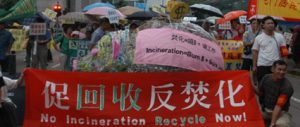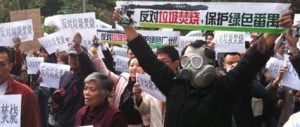Like many of China’s rapidly growing cities, Guangzhou is under siege from landfill. The southern city produces about 18,000 tonnes of household waste every day, 14,000 tonnes of which needs to be disposed of after sorting and recycling. That is as much as the city can handle. Some of the waste is incinerated, but most is sent to landfill, and dumping grounds are slowly surrounding the city.
In a controversial move, the city decided from July to start charging residents for waste disposal according to the number of rubbish bags used. An additional charge will be applied for excess waste. The authorities fear that, as Guangzhou continues to grow, so will the waste produced, leaving its disposal systems struggling to cope.
Wan Qingliang, the city’s Party secretary, has said efforts to sort and reduce waste will fail unless all of the city’s residents take part.
The new charging project includes “to-the-truck” disposal, where residents must place their rubbish bags on the street at a certain time each day to be collected by sanitation workers, as well as special bags for kitchen waste and per-bag charges for household waste.
There is a strict ban on household waste being placed in public bins. If you miss your chance to put the rubbish out one evening, you have to wait until the truck comes around again the next morning. If you miss it again, you can pay a visit to the central collection point for the neighbourhood.
With the per-bag charges, residents still pay 15 yuan (US$2) a month per household for waste disposal, as they did before the new rules. But now they must obtain government-made bags from distribution points and use these to deliver their waste to the truck. Every household gets 60 bags per month and more can be bought for 0.5 yuan (7 cents) – so if you use fewer bags, you can save money.
The bags even have anti-counterfeiting marks, along with serial numbers, so that they can be matched to individual households. If a resident is found not to have sorted their waste, enforcers can track down the culprit. Bao Lunjun, chief engineer at Guangzhou’s urban management commission, explained that the new scheme uses financial incentives to get residents to cut down on waste. Residents who use fewer bags will have their waste disposal fee reduced accordingly – so the less you throw away, the less you pay.
Guangzhou’s mayor, Chen Jianhua, has insisted that the income generated from the cost of the bags will be spent on sorting and handling waste, and is not a ploy to boost government revenues. With extra spending on sorting and transportation, investment in waste management in Guangzhou this year is expected to be higher than last year’s 2.2 billion yuan (US$345 million). Jianhua has also said that said that the serial numbers and data on household waste will not breach privacy.
Taipei successful rubbish charge
Guangzhou’s confidence that the new scheme will work is in large part due to the success of similar moves across the Taiwan Strait in Taipei, which has seen a significant drop in waste volumes in the past decade. In 2000, Taipei was producing 1,834 tonnes of household waste daily. By 2008, that had dropped to 971 tonnes per day, while the recycling rate had rocketed from 9.79% to 42.37%. Construction of 10 rubbish incinerators around the island was put on hold, saving almost 60 billion Taiwanese dollars (US$600 million). Half of the capacity at Taipei’s three incinerators is not currently needed.
And yet, despite the alluring prospects and successful examples, pay-as-you-throw policies are not easy to implement and present challenges for city bosses. To start with, how practical is the scheme? The media have pointed out that Guangzhou has 3.5 million households, ranging from gated communities with mostly educated residents to, more often, less well-managed older buildings, privately-constructed buildings and villages that have been absorbed by the city. The attitude of the residents, observers suggest, will to a large degree determine the success of the policy.
Research by the Department of Geography at National Taiwan University found that many residents would compress rubbish – so they could stuff more in – or use ordinary garbage bags instead of the official ones. Many even took to dumping rubbish on the streets at night, a situation which led to the city’s then mayor Ma Ying-Jeou turning out to join efforts to stop them. Realistically, it may be necessary to resort to CCTV and other technology to make the scheme work properly – but not many Guangzhou neighbourhoods have CCTV cameras.
Success in Taipei has relied on cooperation across all government departments, not just one or two. Hong Kong environmental group The Conservancy Association found that the scheme had the full support of senior city politicians, with Ma Ying-Jeou appearing on public education posters and senior officials displaying rubbish bags at public events.
Different government departments worked together to make the recycling scheme a success. For example, the civil affairs authorities were in charge of raising public awareness, while the education authorities worked with local schools and even the police were involved, dealing with 4,500 reports of rules being broken each day when the scheme first started.
Taipei’s most senior environmental official Chen Yongren said that sorting and recycling waste needs to be “humane” and a system that relies too heavily on penalities won’t work. The Taipei government placed great weight on publicity and education, not only to help the scheme run smoothly, but also to reduce public resistance. Initially, waste sorting was voluntary, but thanks to successful publicity campaigns and the introduction of financial incentives, the city found it relatively easy to make the switch to compulsory sorting in 2005.
Wang Haotong is a journalist based in Beijing.
Homepage image by Y,t




